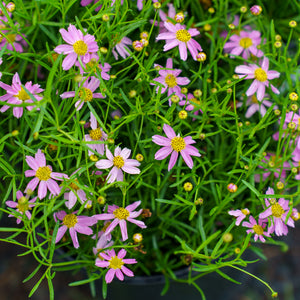The Coreopsis Guide
Coreopsis, commonly known as tickseed, is a cheerful and easy-to-grow perennial that brings a burst of sunny color to gardens from early summer through fall. With daisy-like flowers in hues of yellow, orange, red, and bi-color blends, Coreopsis is beloved by pollinators and gardeners alike. Its long bloom period, drought tolerance, and low-maintenance nature make it an ideal choice for borders, containers, cottage gardens, and native plant landscapes.
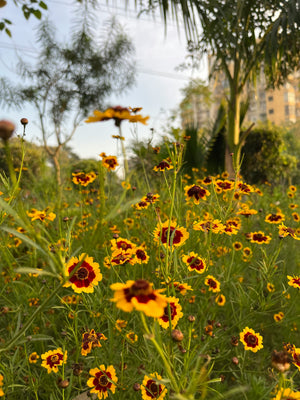
About
Coreopsis is a genus of flowering plants in the Asteraceae family, native to North and South America. Most species are herbaceous perennials, although some are annuals. These plants are known for their profuse blooms, ferny or lance-shaped foliage, and ability to thrive in tough garden conditions. The name “tickseed” comes from the resemblance of the seeds to tiny ticks.
Gardeners have a wide range of cultivars to choose from. Favorites include Coreopsis verticillata 'Moonbeam', with pale yellow flowers and fine, threadleaf foliage; Coreopsis grandiflora 'Early Sunrise', with bright golden double blooms; and Coreopsis 'Jethro Tull', a compact hybrid with golden fluted petals. The Li’l Bang series, including 'Daybreak', 'Starlight', and 'Candy Stripes', offers compact habit and long-lasting blooms, while selections like 'Red Satin', 'Tequila Sunrise', and 'Big Bang Mercury Rising' provide rich, vibrant color. Other highlights include 'Crème Brulee', 'Zagreb', 'Sienna Sunset', and 'Sunstar Rose'.
Coreopsis can be used in traditional garden beds or more naturalistic settings and pairs beautifully with ornamental grasses, salvia, echinacea, and lavender.
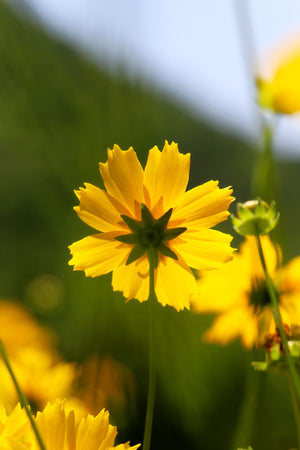
PLANTING
Coreopsis is one of the most forgiving and adaptable perennials you can grow. It thrives in a wide range of garden settings and is ideal for novice gardeners:
- USDA Hardiness Zones: Most perennial varieties grow well in Zones 4–9.
- Soil: Prefers well-drained soil. Tolerates poor soil but benefits from the addition of compost at planting.
- Sunlight: Full sun (6+ hours daily) is ideal for best flowering.
- Watering: Drought-tolerant once established. Water regularly until established, then only during extended dry periods.
- Spacing: Space 12–24 inches apart depending on the variety.
- Planting Time: Plant in spring or early fall to give roots time to establish before extreme weather.
To plant, dig a hole slightly larger than the root ball, place the plant at the same depth, backfill, and water thoroughly. Add mulch to retain moisture and suppress weeds.

CARE
Coreopsis is low-maintenance and long-blooming with just a few basic care practices:
- Watering: Water young plants regularly until established. Mature plants require minimal watering except in drought.
- Fertilizing: Not usually necessary. Too much fertilizer can reduce blooming.
- Deadheading: Remove spent flowers regularly to encourage continuous blooming. Cut plants back by one-third in midsummer for a fresh flush of blooms.
- Pruning: Cut back stems in late fall or early spring to maintain plant shape and vigor.
- Pests & Diseases: Generally pest-resistant. Occasionally affected by mildew or leaf spot in humid conditions—improve air circulation and avoid overhead watering.
- Dividing: Divide clumps every 2–3 years in spring or fall to rejuvenate and prevent overcrowding.
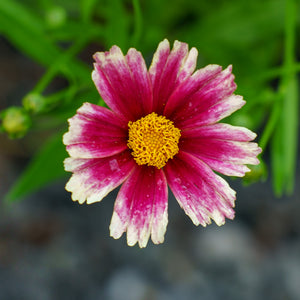
HOW TO USE
Coreopsis brings long-lasting, vibrant color to a variety of garden styles and settings. Its easy care and extended bloom time make it a favorite in many landscape designs:
- Cottage Gardens: Use en masse for an old-fashioned, meadow look.
- Borders & Edging: Compact varieties like 'Li'l Bang Daybreak' and 'Uptick Yellow & Red' are perfect for defining garden beds.
- Pollinator Gardens: Attracts bees, butterflies, and other beneficial insects.
- Containers: Compact and trailing forms work well in pots and planters.
- Cut Flower Gardens: Long stems and cheerful flowers make great additions to bouquets.
Coreopsis pairs well with echinacea, black-eyed Susan, Russian sage, blanket flower, and catmint. Try combining yellow-flowered varieties with purple or blue-toned companions for bold contrast.
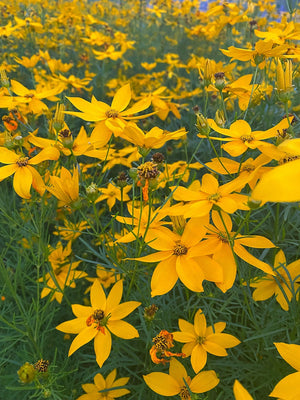
COMMON QUESTIONS
- Is Coreopsis a perennial? Most varieties are perennials, though some species are annuals. Many modern cultivars are hardy and return year after year.
- Do deer eat Coreopsis? Coreopsis is considered deer-resistant, though no plant is completely deer-proof.
- How to prune 'Li’l Bang Daybreak' Coreopsis? Deadhead regularly and shear back midsummer by about one-third to encourage new growth and blooms.
- Why is Coreopsis called tickseed? The name comes from the appearance of the seeds, which resemble small ticks.
- How to deadhead Coreopsis? Use clean scissors or pruners to snip spent blooms just above a leaf node or bud.
- Are Coreopsis toxic to dogs? Coreopsis is generally considered non-toxic to dogs.
- Are Coreopsis toxic to cats? Coreopsis is generally considered non-toxic to cats.
- Do rabbits eat Coreopsis? Coreopsis is not a preferred food for rabbits and is often avoided.
- Does Coreopsis spread? Some species can self-seed or form clumps that gradually expand, but most are well-behaved.
- When does Coreopsis bloom? Coreopsis typically blooms from early summer to fall, especially with regular deadheading.
Conclusion
Coreopsis is a garden favorite for a reason—it's colorful, dependable, and low-maintenance. With options ranging from golden classics like 'Early Sunrise' to vivid new introductions like 'Red Satin' and 'Ice Wine', there’s a Coreopsis for every garden palette. Whether you're planting a pollinator-friendly border, filling containers, or adding long-lasting summer color to your beds, Coreopsis delivers season after season.
The Coreopsis Collection
Sold Out
Sold Out
Sold Out
Sold Out

